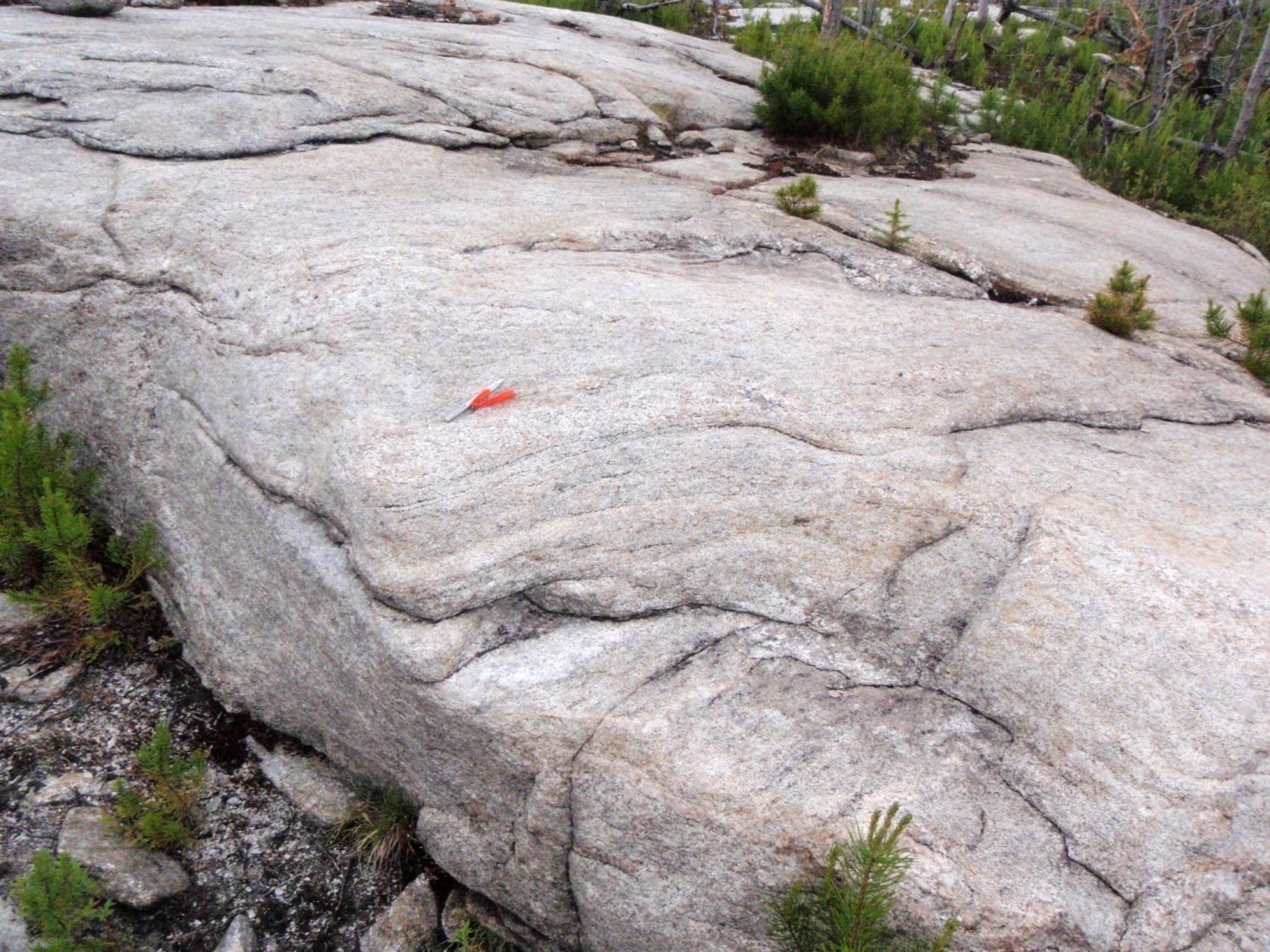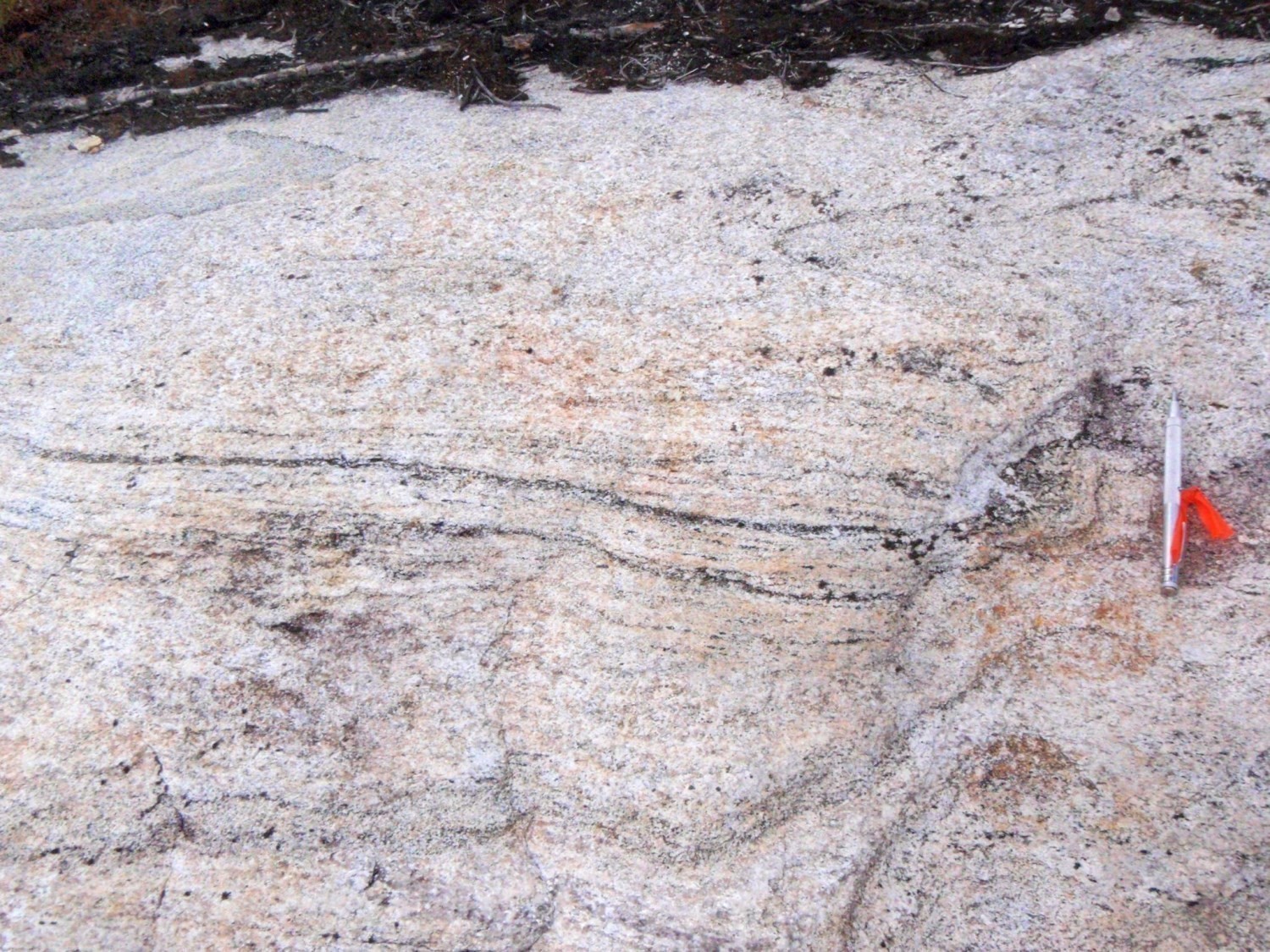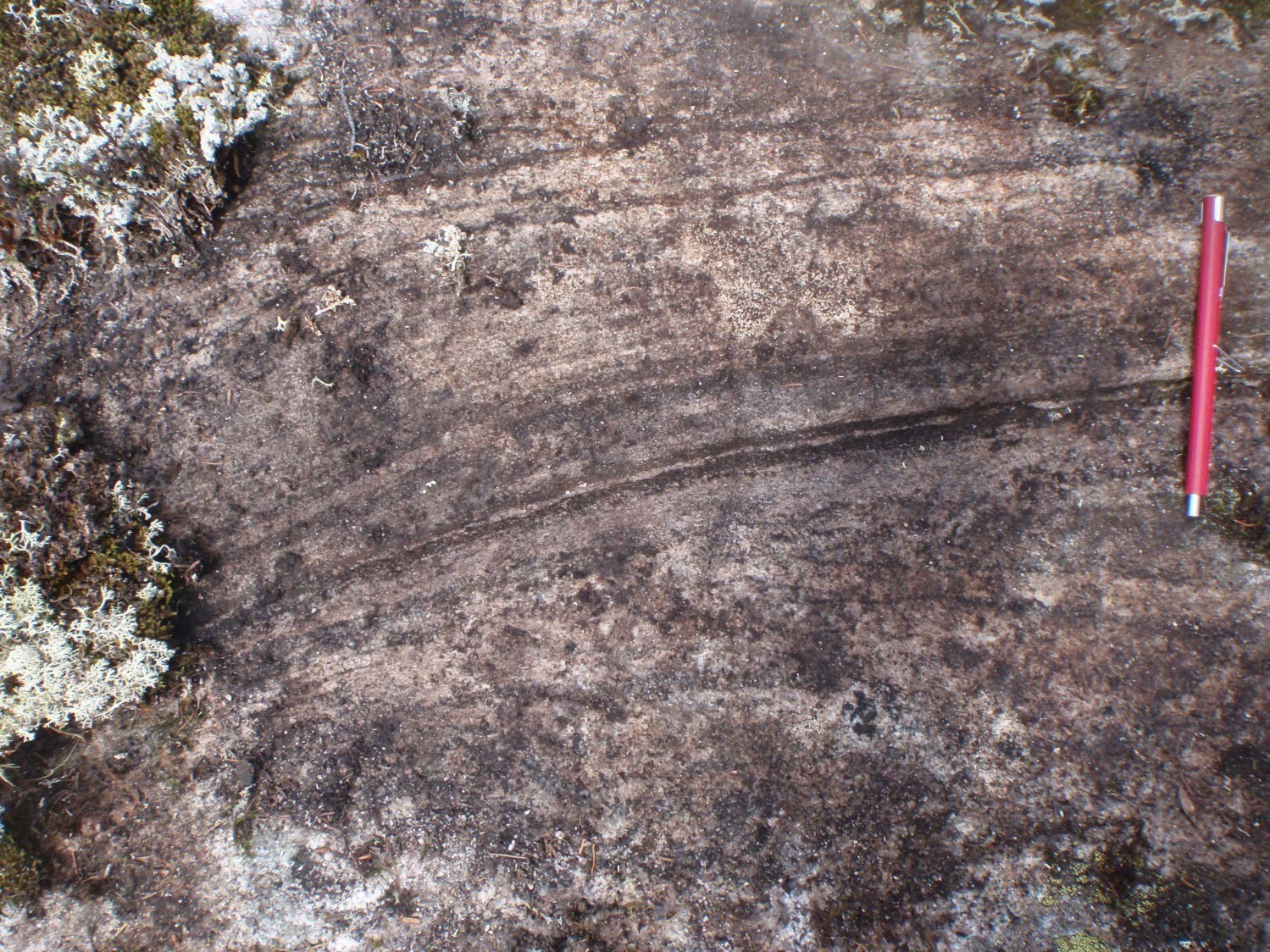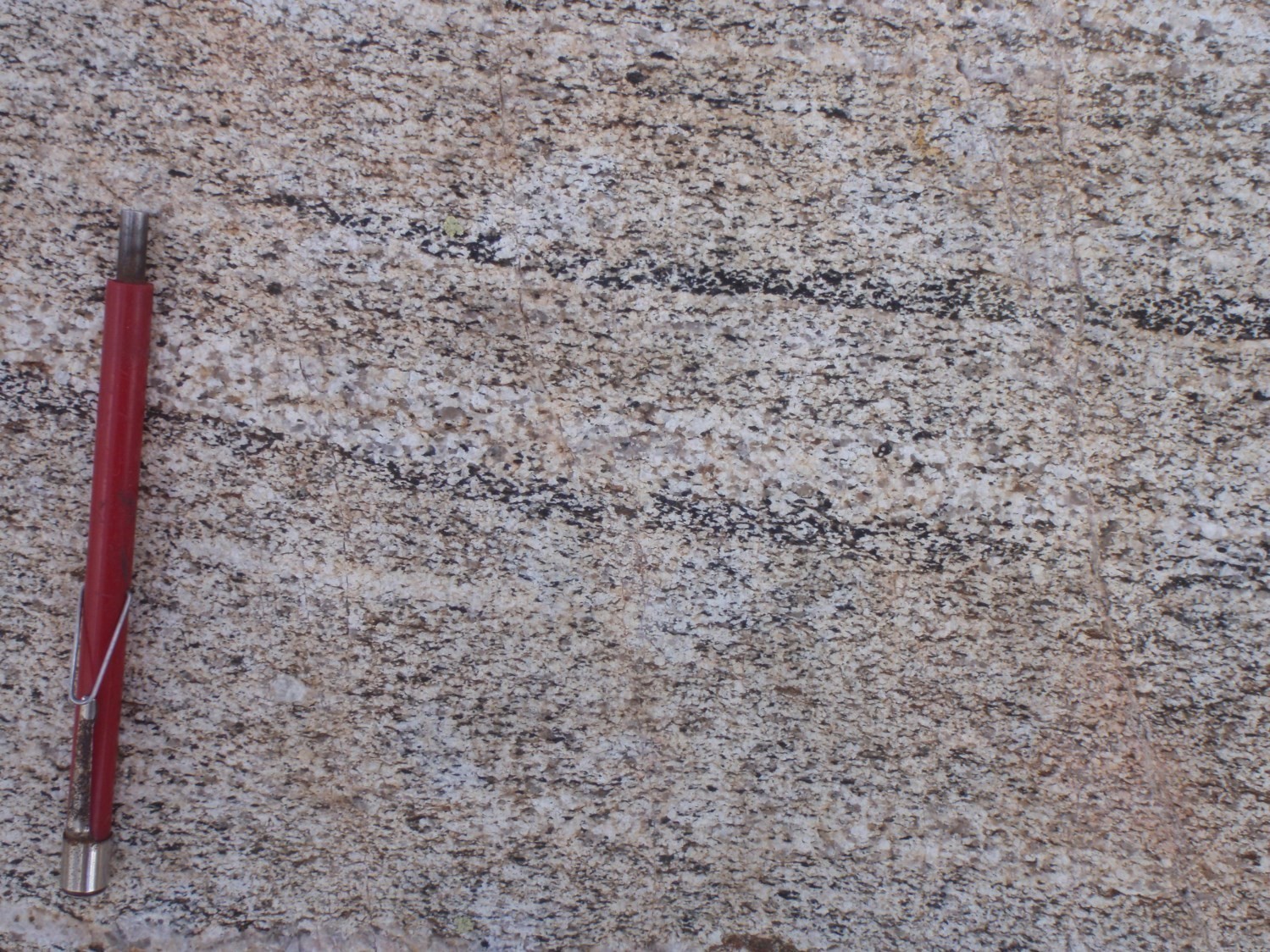
DISCLAIMER: This English version is translated from the original French. In case of any discrepancy, the French version shall prevail.
| Author(s): | Bandyayera and Caron-Côté, 2019 |
| Age: | Archean |
| Stratotype: | None |
| Type area: | Western area of Hutte Lake (NTS sheet 32O12) |
| Geological province: | Superior Province |
| Geological subdivision: | Nemiscau Subprovince |
| Lithology: | Plutonic and metamorphic rocks |
| Category: | Lithodemic |
| Rank: | Complex |
| Status: | Formal |
| Use: | Active |
None
Background
The Hutte Complex was introduced by Bandyayera and Caron-Côté (2019) to group gneissic and tonalitic rocks mapped in NTS sheets 32O11, 32O12 and 32O14, which form a dome in the central part of the Lac des Montagnes Belt, initially located in the Nemiscau Subprovince. These authors subsequently reassigned to the Hutte Complex all migmatized plutonic and gneissic masses located within the Nemiscau Subprovince (sheets 32N06 to 32N09) that were originally assigned to the Champion Complex (Bandyayera et Daoudene, 2018 et 2019), restricting the Champion Complex to the La Grande Subprovince. As a result of the work of Pedreira Pérez et al. (2019), Pedreira Pérez et al. (2020), and Bandyayera et al. (2022), the Lac des Montagnes Belt is no longer considered part of the Nemiscau Subprovince, but rather part of the La Grande Subprovince. The plutonic and gneissic masses associated with the Nemiscau Subprovince have therefore been reassigned to a new unit, the Wettigo Complex. Thus, the Hutte Complex now includes only the gneissic and tonalitic rocks mapped within the Lac des Montagnes Belt that separates the La Grande and Opatica subprovinces.
The table below presents the Hutte Complex units and corresponding units from previous reports:
|
Revised Units: Bandyayera et Caron (2019, 2021) |
Bandyayera et al. (in preparation) | Bandyayera et Daoudene (2018 et 2019) |
|---|---|---|
| Ahue1 | mAwti1 | Achp1 |
| Ahue2 | Awti3 | Achp2 |
Description
The Hutte Complex consists of a package of plutonic-gneissic rocks of a generally tonalitic composition and, more locally, granodioritic or granitic. The different units that compose it are the following:
- tonalitic and locally granitic gneiss, granodiorite (Ahue1);
- foliated biotite ±hornblende tonalite (Ahue2);
- foliated granite (Ahue3)
Hutte Complex 1 (Ahue1): Tonalitic Gneiss, Locally Granitic; Granodiorite in Some Areas
The tonalitic to locally granitic gneisses are pale grey on the altered surface and greyish on the fresh surface. The grain size is generally medium, but can be locally coarse or, more rarely, fine. These gneisses are usually homogeneous, but show some heterogeneity in places. This heterogeneity is due to several causes, including variations in grain size that can change rapidly from fine to coarse, and the presence of diorite enclaves and pegmatitic granite injections without preferential direction. The Ahue1 unit is weakly to strongly magnetic and shows foliated, folded and banded structures. The gneissic structure is defined essentially by alternating grayish millimetric to centimetric bands rich in biotite and hornblende (~15%) with whitish bands richer in plagioclase (>50%). The banding is locally accentuated by centimetric injections of pink granite or granodiorite arranged parallel to the foliation planes. This banding becomes even more pronounced in the vicinity of deformation zones. The fine- to medium-grained tonalitic ribbons are partially to completely recrystallized. The most common accessory minerals are biotite (10-15%), hornblende (1-5%) and magnetite (trace-3%). The magnetite content is more important in the gneisses east of Glas Lake. In thin section, the biotite is locally chloritized and contains zircon inclusions. There are also traces of apatite, sphene and allanite. The gneiss typically contains 1 to 20% decimetric to metric enclaves or decametric strips of foliated, locally gneissic, magnetic diorite. Granitic gneiss outcrops mainly SW of Indien Lake in the Champion Lake area (sheet 32N09). The rock is medium to coarse grained, heterogranular, highly foliated to gneissic, and pink both on altered and fresh surfaces.
Hutte Complex 2 (Ahue2): Foliated Biotite ± Hornblende Tonalite
 The biotite ±hornblende tonalite is intensely foliated, locally gneissic. The rock is homogeneous, medium grained, light gray on altered surface and dark gray on fresh surface. The rock typically contains 15% biotite, 5% hornblende and traces of magnetite. The Ahue2 unit contains 2-5% enclaves of homogeneous, granoblastic diorite that is dark gray on both altered and fresh surfaces. These enclaves are strongly stretched parallel to the foliation planes and include 40-50% ferromagnesian minerals (biotite and hornblende). The rock is cut by several multiphase injections of pegmatitic and massive pink granite, locally showing a lining of biotite, that can be confused with a structure commonly associated with partial melting.
The biotite ±hornblende tonalite is intensely foliated, locally gneissic. The rock is homogeneous, medium grained, light gray on altered surface and dark gray on fresh surface. The rock typically contains 15% biotite, 5% hornblende and traces of magnetite. The Ahue2 unit contains 2-5% enclaves of homogeneous, granoblastic diorite that is dark gray on both altered and fresh surfaces. These enclaves are strongly stretched parallel to the foliation planes and include 40-50% ferromagnesian minerals (biotite and hornblende). The rock is cut by several multiphase injections of pegmatitic and massive pink granite, locally showing a lining of biotite, that can be confused with a structure commonly associated with partial melting.
Hutte Complex 3 (Ahue3): Foliated Granite
The granite is medium to coarse grained, locally pegmatitic. It is slightly to moderately magnetic. It is medium light pink on a fresh surface and light pink on an altered surface. The rock is foliated to locally gneissic. It is homogeneous and contains 3-10% biotite and 1-3% magnetite.
Thickness and Distribution
Most of the rocks in the Hutte Complex form domes 3 to 12 km long and 0.5 to 5 km wide. They are mainly located in sheets 32N09, 32O12, 32O14 and 32O15. They are elongated along a NE-SW axis and spatially associated with the Lac des Montagnes Belt. In the Lac de la Marée region (sheet 32O16), the orientation of the Hutte Complex units, as well as the Lac des Montagnes Belt that encloses them, changes from NE-SW to E-W (Bandyayera and Caron-Côté, 2022).
Dating
Two ages were obtained for the tonalitic gneisses of the Hutte Complex. The sample from outcrop 2017-DT-5144 yielded a metamorphic age of 2804 ±5.1 Ma, interpreted as that of the gneiss, and an age of 2952.2 ±3.8 Ma, interpreted as that of the protolith of the gneissic tonalite. Bayesian modelling of the same geochronological data from sample 2017-DT-5144A suggests two distinct ages at 2792.0 ±2.7 Ma and 2834.8 ±4.1 Ma, which is an alternative interpretation of the tonalitic gneiss age. The sample from outcrop 2018-CS-4142 yielded an age of 2790.4 ±5.4 Ma, interpreted as the protolith of the tonalitic gneiss.
These ages support the interpretation that the gneissic unit (Ahue1) corresponds to a Mesoarchean basement on which supracrustal rock units such as the Lac des Montagnes Group and the Voirdye Formation were deposited.
| Unit | Sample Number | Isotopic System | Mineral | Crystallization Age (Ma) | (+) | (-) | Metamorphic Age (Ma) | (+) | (-) | Reference(s) |
| Ahue1 | 2017-DT-5144A | U-Pb | Zircon | 2952.2 | 3.8 | 3.8 | 2804.6 | 5.1 | 5.1 | David, 2020a |
| 2018-CS-4142A | U-Pb | Zircon | 2790.4 | 5.4 | 5.4 | 2691 | 11 | 11 | David, 2020b |
Stratigraphic Relationship(s)
Although the contact between the Hutte Complex and supracrustal rocks could not be observed at any outcrop, the age of the Ahue1 unit (David, 2020a-b) and the piling of volcano-sedimentary units suggest that the Hutte Complex forms the basement on which the Lac des Montagnes Group and Voirdye Formation were deposited. In addition, subhorizontal foliation observed in the Hutte Complex supports the interpretation that the unit consists of domes exposed in windows in the axial part of anticlines. The Hutte Complex is cut by Proterozoic diabase dykes belonging to the Mistassini and, more locally, Senneterre dyke swarms.
Paleontology
Does not apply.
References
Publications Available through Sigéom Examine
BANDYAYERA, D., CARON-CÔTE, E. 2019. Geology of the Montagnes Lake area, La Grande, Nemiscau and Opatica subprovinces, Eeyou Istchee James Bay, Québec, Canada. MERN. BG 2019-03, 1 plan.
BANDYAYERA, D., CARON-CÔTE, E. 2021. Géologie de la région du lac Le Vilin, sous-provinces de La Grande et d’Opatica, Eeyou Istchee Baie-James, Québec, Canada. MERN. BG 2022-03, 1 plan.
BANDYAYERA, D., CARON-CÔTÉ, E., 2022. Géologie de la région du lac de la Marée, sous-provinces de l’Opatica et de La Grande, Eeyou Istchee Baie-James, Québec, Canada. MERN; BG 2023-03, 1 plan.
BANDYAYERA, D., CARON-CÔTÉ, E., PEDREIRA PÉREZ, R., CÔTÉ-ROBERGE, M., CHARTIER-MONTREUIL, W., 2022. Synthèse géologique de la Sous-province de Nemiscau, Eeyou Istchee Baie-James, Québec, Canada. MERN; BG 2021-03, 1 plan.
BANDYAYERA, D., DAOUDENE, Y. 2018. Geology of the Champion Lake region, La Grande and Nemiscau subprovinces, east of Waskaganish, Eeyou Istchee James Bay, Québec, Canada. MERN. BG 2018-06, 2 plans.
BANDYAYERA, D., DAOUDENE, Y., 2019. Géologie de la région du lac Nemiscau, secteur ouest de la rivière Rupert (SNRC 32N06, 32N07 et 32N11). MERN. RG 2018-03, 58 pages, 1 plan.
DAVID, J., 2020a. Datations U-Pb dans les provinces du Supérieur et de Churchill effectuées au GEOTOP en 2017-2018. MERN. MB 2020-05, 29 pages.
DAVID, J., 2020b. Datations U-Pb dans les provinces du Supérieur et de Churchill effectuées au GEOTOP en 2018-2019. MERN. MB 2020-01, 30 pages.
PEDREIRA PÉREZ, R., TREMBLAY, A., DAOUDENE, Y., BANDYAYERA, D., 2019. Étude structurale du secteur sud-est de la Sous-province de Nemiscau, Baie-James, Québec; résultats préliminaires. UQAM, MERN. MB 2019-07, 68 pages.
PEDREIRA PÉREZ, R., TREMBLAY, A., DAOUDENE, Y., BANDYAYERA, D., 2020. Étude géochimique, structurale et géochronologique de la sous-province de Nemiscau, Baie-James, Québec : implications quant à l’origine et l’évolution tectonique d’un domaine sédimentaire archéen. UQAM, MERN. MB 2020-07, 97 pages.
Suggested Citation
Ministère de l’Énergie et des Ressources naturelles (MERN). Hutte Complex. Quebec Stratigraphic Lexicon. https://gq.mines.gouv.qc.ca/lexique-stratigraphique/province-du-superieur/complexe-de-la-hutte_en [accessed on Day Month Year].
Contributors
|
First publication |
Emmanuel Caron-Côté, P. Geo., M.Sc. emmanuel.caron-cote@mern.gouv.qc.ca (redaction) Mehdi A. Guemache, P. Geo., Ph.D. (coordination); Patrice Roy, P. Geo., M.Sc. (critical review); Simon Auclair, P. Geo., M.Sc. (editing); Céline Dupuis, P. Geo., Ph.D. (English version); Nathalie Bouchard (HTML editing). |
|
Revision(s) |
Daniel Bandyayera, P. Geo., Ph.D. daniel.bandyayera@mern.gouv.qc.ca; Emmanuel Caron-Côté, P. Geo., M.Sc. emmanuel.caron-cote@mern.gouv.qc.ca (redaction) Mehdi A. Guemache, P. Geo., Ph.D. (coordination); Claude Dion, Eng., M.Sc. (critical review); Simon Auclair, P. Geo., M.Sc. (editing); Dominique Richard, GIT, Ph.D. (English version); André Tremblay (HTML editing). |






